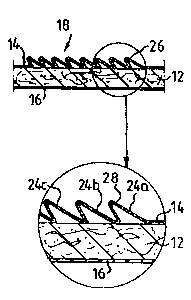Une partie des informations de ce site Web a été fournie par des sources externes. Le gouvernement du Canada n'assume aucune responsabilité concernant la précision, l'actualité ou la fiabilité des informations fournies par les sources externes. Les utilisateurs qui désirent employer cette information devraient consulter directement la source des informations. Le contenu fourni par les sources externes n'est pas assujetti aux exigences sur les langues officielles, la protection des renseignements personnels et l'accessibilité.
L'apparition de différences dans le texte et l'image des Revendications et de l'Abrégé dépend du moment auquel le document est publié. Les textes des Revendications et de l'Abrégé sont affichés :
| (12) Demande de brevet: | (11) CA 2194179 |
|---|---|
| (54) Titre français: | ARTICLE ABSORBANT |
| (54) Titre anglais: | ABSORBENT ARTICLE |
| Statut: | Réputée abandonnée et au-delà du délai pour le rétablissement - en attente de la réponse à l’avis de communication rejetée |
| (51) Classification internationale des brevets (CIB): |
|
|---|---|
| (72) Inventeurs : |
|
| (73) Titulaires : |
|
| (71) Demandeurs : | |
| (74) Agent: | SMART & BIGGAR LP |
| (74) Co-agent: | |
| (45) Délivré: | |
| (86) Date de dépôt PCT: | 1995-06-07 |
| (87) Mise à la disponibilité du public: | 1996-02-01 |
| Licence disponible: | S.O. |
| Cédé au domaine public: | S.O. |
| (25) Langue des documents déposés: | Anglais |
| Traité de coopération en matière de brevets (PCT): | Oui |
|---|---|
| (86) Numéro de la demande PCT: | PCT/SE1995/000671 |
| (87) Numéro de publication internationale PCT: | WO 1996002216 |
| (85) Entrée nationale: | 1996-12-30 |
| (30) Données de priorité de la demande: | ||||||
|---|---|---|---|---|---|---|
|
Article absorbant (10) tel qu'une couche, une protection pour incontinence ou analogue, comprenant un corps (12) absorbant de forme allongée, enfermé entre une couche (14) recouvrante supérieure perméable aux liquides et une couche (16) recouvrante inférieure imperméable aux liquides. De manière à empêcher les fèces de venir vers une zone antérieure d'absorption de l'urine, l'invention présente des moyens d'arrêt comprenant au moins deux éléments (24a, 24b, 24c...) élastiques adjacents sous forme de bande qui s'étendent transversalement sur l'intérieur de l'article (10), qui, lorsque l'article est à l'état plat, sont préalablement tendus dans leur direction longitudinale et qui s'étendent, au moins dans l'état d'utilisation de l'article, vers l'arrière en saillant de celui-ci par rapport à leur bord longitudinal faisant face à l'article.
The invention relates to an absorbent article (10), such as a diaper, an
incontinence protecter or the like, comprising an elongated absorbent body
(12), enclosed between a proximal liquid permeable cover layer (14) and a
distal liquid impermeable cover layer (16). In order to prevent faeces from
being transferred to a front, urine absorbing area of the article, it is
suggested according to the invention a barrier means, which comprises at least
two, adjacent to each other, strip-shaped elastic elements (24a, 24b, 24c ...)
extending transversely over the inside of the article (10), said elements in a
flat state of the article, being pretensioned in their longitudinal direction
and at least in the use state of the article, extending backwards and out from
the article, relative to a longitudinal edge of the strip-shaped elements
facing towards the article.
Note : Les revendications sont présentées dans la langue officielle dans laquelle elles ont été soumises.
Note : Les descriptions sont présentées dans la langue officielle dans laquelle elles ont été soumises.

2024-08-01 : Dans le cadre de la transition vers les Brevets de nouvelle génération (BNG), la base de données sur les brevets canadiens (BDBC) contient désormais un Historique d'événement plus détaillé, qui reproduit le Journal des événements de notre nouvelle solution interne.
Veuillez noter que les événements débutant par « Inactive : » se réfèrent à des événements qui ne sont plus utilisés dans notre nouvelle solution interne.
Pour une meilleure compréhension de l'état de la demande ou brevet qui figure sur cette page, la rubrique Mise en garde , et les descriptions de Brevet , Historique d'événement , Taxes périodiques et Historique des paiements devraient être consultées.
| Description | Date |
|---|---|
| Inactive : CIB désactivée | 2011-07-29 |
| Inactive : CIB dérivée en 1re pos. est < | 2006-03-12 |
| Inactive : CIB de MCD | 2006-03-12 |
| Demande non rétablie avant l'échéance | 2000-06-07 |
| Le délai pour l'annulation est expiré | 2000-06-07 |
| Réputée abandonnée - omission de répondre à un avis sur les taxes pour le maintien en état | 1999-06-07 |
| Demande publiée (accessible au public) | 1996-02-01 |
| Date d'abandonnement | Raison | Date de rétablissement |
|---|---|---|
| 1999-06-07 |
Le dernier paiement a été reçu le 1998-05-21
Avis : Si le paiement en totalité n'a pas été reçu au plus tard à la date indiquée, une taxe supplémentaire peut être imposée, soit une des taxes suivantes :
Veuillez vous référer à la page web des taxes sur les brevets de l'OPIC pour voir tous les montants actuels des taxes.
| Type de taxes | Anniversaire | Échéance | Date payée |
|---|---|---|---|
| TM (demande, 2e anniv.) - générale | 02 | 1997-06-09 | 1997-05-30 |
| TM (demande, 3e anniv.) - générale | 03 | 1998-06-08 | 1998-05-21 |
Les titulaires actuels et antérieures au dossier sont affichés en ordre alphabétique.
| Titulaires actuels au dossier |
|---|
| SCA MOLNLYCKE AB |
| Titulaires antérieures au dossier |
|---|
| GUNILLA HEDLUND |